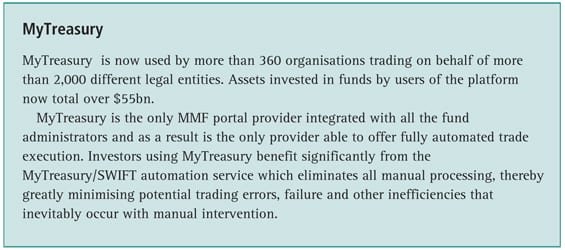by Justin Meadows, Founder and Chief Executive, MyTreasury
The money market fund (MMF) industry is about to go through a period of significant transition driven by both impending regulatory change and a sustained period of very low interest rates. However, whilst the main options for change have been widely publicised and debated, both fund providers and investors remain unclear about precisely how they will impact the future MMF landscape. They don’t yet know which options will be implemented, when they will be introduced and how consistent they will be across US onshore and offshore funds domiciled within the EU. Nor do they know how long low interest rates will be around and how much and how quickly they will rise when this does eventually happen. In this climate it is not surprising to find that funds and investors have engaged in both short-term tactical behaviour and more long-term strategic planning to ensure that they have managed the recent difficulties as well as they could and are properly prepared for any anticipated and unexpected changes that are finally implemented. These changes inevitably have knock on consequences for MMF portal providers who have to make sure they will continue to be able to support the needs of both investors and participating funds in a changing world.
Changes to existing funds
Impending regulatory change and the sustained low interest rate environment – particularly in the Eurozone – have led to a number of changes to existing funds over the past two years.
In the short term perhaps the most dramatic response was the complete (hard) closure of some EUR funds by some providers who could not see how they could continue to deliver a sustainable and attractive investment opportunity in such a difficult environment. Hard fund closures do not pose significant problems to portals as they simply require the removal of the relevant funds from market view and switching off the ability of investors to trade them through the platform. Other changes however have presented more significant challenges to the portal providers.
Many of the EUR funds that were not hard closed were subject to soft closures with either no new investments being allowed for specific periods or maximum trade values being set for new investments. This kind of dynamic investment framework creates considerably more difficulties for portals as it requires the ability to provide up to date information on changing investment guidelines for each fund as well as ensuring that investors do not inadvertently breach these, or attempt to do so, through their use of the portal. Whilst this involved some portals in new development work it probably gave all of us an insight into the more heterogeneous fund landscape that we may all be dealing with in future and hence the need for greater flexibility and configurability to adapt quickly and easily to emerging requirements.
Sign up for free to read the full article
Register Login with LinkedInAlready have an account?
Login
Download our Free Treasury App for mobile and tablet to read articles – no log in required.
Download Version Download Version


























